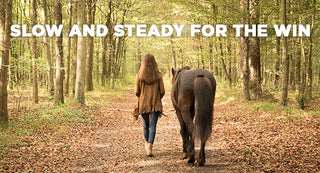Training Tip
Slowing down a horse that rushes when being ledAhhh... finally, you pull back the stall door or the paddock gate for some quality horse time after a hectic day. This will be some relaxing time together you think....until your horse starts rushing past you and your tranquil vision is suddenly interrupted by a lack of harmony. Ugh.... A horse that gets rushy on the ground is a fixable habit that you can overcome with some patience and the right tools.
- Have the right tools for the job, if you know that your horse is apt to be a little pushy after time in his stall, or in excitement to get back to feed at night, be sure to stack the odds in your favor with the right tools. The patented Hybrid Halter can be especially helpful for rushy horses because of the superior control it provides compared to a leather, nylon or rope halter. Make sure your lead rope can convey some energy (cotton and poly lead ropes have a floppy dead feeling and don't convey energy, so Yachting Braid Ropes are a better choice). You'll also want to make sure your rope is long enough to correct your horse if he rushes, and can also drape on the ground or close to the ground for a good release when he's patient. A horsemanship stick will also help enforce your directions.
- Set the expectation. Set an expectation of where you want your horse to lead, even with your shoulder, or a step behind you are recommended generally, based on your preference. Take a mental note of that sweet spot and stay mindful while you are leading so that you can make a correction when your horse rushes through this imaginary boundary.
- Use synchronicity to your advantage. Horses naturally seek to harmonize. You can emphasize this tendency and get your horse to match your exact footstride if you are mindful of it. You'll want to put your feet in time with your horse's stride first, then, once you both have the hang of harmony, you can pump the brakes and if your horse overshoots the stop, ask him to back up. And most importantly, WAIT patiently. The wait will give your horse the chance to think on the purpose of the lesson. If your horse is rare to rush and easily corrected, you may only need to pause ten seconds before going on your way. If however he's a speed racer, be sure to make the wait long enough to have some influence.
-
Fidgeting is rushing in place. If you ask your horse to wait and he can't sit still, that's the same as rushing. Ask him to back up and wait again until he can stand without fidgeting. When you ask your horse to wait, trust him to do so and put a big drape in the lead to give him a noticeable release for doing the right thing.
PRO TIP: If you are using a HYBRID Halter ask for the back with a side to side motion, think of alternating bumps of rhythmic pressure towards either shoulder. This alternating movement will engage the nose knots on the halter, giving you the most efficient and effective correction. - Mind your energy. If you're mindful of your steps, your horse will be. Be sure to audit yourself and make sure you aren't conveying "go-go, now, faster" body language to your horse.
Products that can help with common horsemanship goals:
For the horse: Patented Hybrid Halter, 8' Lead and Tie Rope, Educated Young Horse on the Ground DVD
For the horse: Patented Hybrid Halter, 8' Lead and Tie Rope, Educated Young Horse on the Ground DVD

